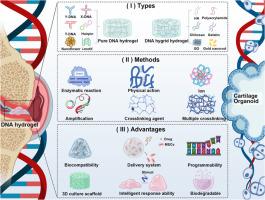基于 DNA 的水凝胶:软骨组织细胞的理想生物材料
IF 6.3
3区 综合性期刊
Q1 Multidisciplinary
引用次数: 0
摘要
骨关节炎(Osteoarthritis, OA)是一种常见的退行性疾病,致残率高,给个人和社会造成了巨大的经济负担。由于关节软骨的自我修复能力有限,现有的治疗方法仍不能有效治疗OA。类器官是由干细胞或器官祖细胞分化而来的多细胞结构,可用于疾病模型。未来的应用可以提供其他器官替代策略。因此,构建软骨类器官有望克服现有治疗方法的不足,实现OA的有效治疗。类器官的构建需要类似于细胞外基质(ECM)的三维网络支架来支持细胞扩增。水凝胶具有亲水性的天然网状结构。因此,它可以模拟ECM,为细胞生长提供机械支持和有利的微环境。DNA水凝胶主要由DNA形成。它保留了DNA的可编程性、生物相容性和生物降解性,并具有独特的机械性能。因此,它是构建软骨类器官的理想材料。本文对制备方法进行了综述,并对DNA水凝胶在类软骨器官构建中的应用进行了探讨,旨在为基于DNA水凝胶的类软骨器官构建和设计提供参考。本文章由计算机程序翻译,如有差异,请以英文原文为准。

DNA-based hydrogels: Ideal biomaterials for cartilage organoids
Osteoarthritis (OA) is a common degenerative disease with high disability rate, imposing significant economic burdens on individuals and society. Due to the limited self-repair ability of articular cartilage, the existing treatment methods still cannot effectively treat OA. Organoids are multicellular structures differentiated from stem cells or organ progenitors and can be used to model disease. Future applications can provide alternative organ replacement strategies. Therefore, constructing cartilage organoids is expected to overcome the shortcomings of the existing treatment methods to achieve effective treatment of OA. The construction of organoids requires three-dimensional network scaffolds resembling extracellular matrix (ECM) to support cell expansion. Hydrogel has a hydrophilic natural network structure. Hence it can mimic the ECM, providing mechanical support and a favorable microenvironment for cell growth. DNA hydrogel is mainly formed by DNA. It preserves DNA's programmability, biocompatibility and biodegradability, and has unique mechanical properties. Thus, it is an ideal material for constructing cartilage organoids. This review summarized the preparation methods and discussed the use of DNA hydrogels in the construction of cartilage organoids, aiming to provide a reference for the construction and design of cartilage organoids based on DNA hydrogels.
求助全文
通过发布文献求助,成功后即可免费获取论文全文。
去求助
来源期刊

Fundamental Research
Multidisciplinary-Multidisciplinary
CiteScore
4.00
自引率
1.60%
发文量
294
审稿时长
79 days
期刊介绍:
 求助内容:
求助内容: 应助结果提醒方式:
应助结果提醒方式:


